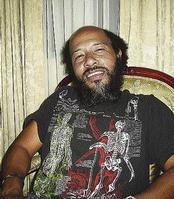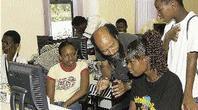Barbara Ellington, Lifestyle Editor

Fine arts major and professor at the University of Boulder, Colorado, in the United States, is happy to be giving back to his country. - Barbara Ellington/Lifestyle Editor
Professor Albert Chong is an accomplished lecturer, photographer, sculptor, installation artist and videographer whose 17-page resume makes very impressive reading. But he remains focused, grounded in his love for Jamaica, devoted to students at the University of Boulder, Colorado, where he resides and happy to finally find a vehicle to help his countrymen.
Flair spoke with Chong who is the principal instructor for a group of 20 inner-city teens who are learning the art of photography over a five-week period. The programme was born out of discussions with Maxine Stowe, the workshop's conceptualiser and is funded by Super Plus Food Stores whose CEO Wayne Chen bought all the cameras for the students' use. It aims to give participants another alternative to activities that negatively impact on their lives.
Camera Club
Chong knows first-hand how the life of a teen can be easily influenced. As a 14-year-old at Kingston College in the '70s, he knew he was hooked when he saw a negative slowly turn into a photograph in the dark room of the school's camera club.
"I used to spend time keeping cool in the dark room after football because it was so hot outside. The room was air-conditioned with black walls. I had been invited by friends to join the club many times, but one day I looked at an image in the tray and it was like the universe had revealed its secrets," Chong said. "It was my epiphany that revealed the potential of what could be put on film, what I could imagine, I suddenly realised I did not need to draw or paint," he continued. And he already had a camera his father had given him a year earlier.
The discovery led young Chong to immediately join the camera club; the older boys taught him everything and he went on to become club president. He also later won prizes in the Jamaica Cultural Development Commission's (JCDC) Festival Competition.
With migration plans in its advanced stages for his family, the budding photographer moved to New York in 1977. In his words, "I spent the first six months watching television and soaking up the culture."
Challenge
College selection was a challenge because he did not want to take a traditional degree course and was not aware that he could attend a visual arts institution until someone pointed that out to him. Armed with a list of relevant colleges, he made the choice and graduated with honours. He completed his masters in fine arts degree eight years later.
"That was a big experience involving openness, tolerance, understanding of lifestyles and cultures, points of view and the fact that we can all coexist," Chong said. The artist who at that time embraced Rastafarianism said his first exhibition comprised a series of self-portraits (Itraits).
He no longer wears the trademark locks but Rasta is still a part of who he is. He began to get notice from the New York art scene because his works had a unique, introspective quality about them.
"I plugged into the black art scene in New York; it was just opening up to people of colour. It was, and to some extent still a racist scene; blacks were locked out but we broke through and began showing our work," Chong told Flair. Government recognition came too and with it a period of multiculturalism and cultural politics.
Recently elevated to full professor, Chong had his first major exhibition in 1983 and has since then had the distinction of having his works shown in very major museum including the Museum of Modern Art. He teaches contemporary art to students aged 18-24 and loves his charges but having given his best years to affluent Caucasions, it feels deeply gratifying to be helping his own.
Efforts in Vain
"Very few children of African descent make my classes so I now feel I'm helping those whom I should. I have been trying to do this for years but my efforts were in vain. And he likes the fact tat the youngsters in the Summer programme are all eager to learn. "We begin at eight in the mornings, we allow them to express themselves, we talk a lot about life and I tell them to respect all forms of life from an ant to an elephant. I want to drive home the point that generally, killing is not a good idea and all life is precious. But the only rule is that they must learn by having fun,"
It is hoped that the group will capture themselves, their families and communities so they can be better understood. Chong's aim is not to turn them into artists but to do some of what schools are not doing for them in the hope that they will become catalysts for change in the society. So along with six volunteers, Chong teaches them to make eye contact in discussions, listen more in order to learn and then they play football every afternoon and the have a field trip once weekly.
Social Intervention

Jamaican photographer, Albert Chong with his digital photography summer workshop at the University of the West Indies, Mona, on Thursday, July 27. - Colin Hamilton/ Freelance Photographer
The general aim of the five weeks is to play a role in social intervention and if photography opens possibilities for the children, there will be some recovery of human potential. Hence, no name-calling or derogatory terms must be used in communication.
Chong feels more money should be put into education and aims to leave with the group a sense of 'other available options'; that they can achieve what they want. "They are learning to use the Internet, take pictures, download them, then we will prepare for an exhibition afterwards and we teach them that they can use the camera to vent, create, record and be archivists for their families," he said.
For the immediate future, the father of two artistic children is on sabbatical and will have his next exhibition in Washington D.C. at the Museum of the Americas. It will be part of the celebration of Jamaica's 44th year of independence. This week in that city, he will participate in a discussion on ways that Jamaica can effect change through the arts but returns to complete the workshop which ends on August 3. The works of the group will be displayed at Oakton House in Half-Way Tree.
In the long term, Chong now 48, sees himself returning home so he is already putting those wheels in motion by planting fruit trees on his family property in St. Catherine.

